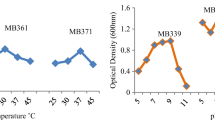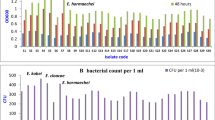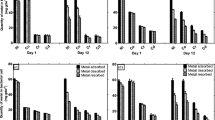Abstract
A novel strain of the genus Micrococcus isolated from wastewater was studied for resistance to seven heavy metals and forty antibiotics. Its capacity to accumulate metal ions was also realized at different pH. The strain exhibited high minimal inhibitory concentration values for metal ions tested and resist to 15 antibiotics. The living cells of the bacterial strain show a largest uptake capacity at pH 6–8.5 for copper, nickel, and zinc with values ranging from 51.45 to 83.90 %, 52.59 to 78.81 %, and 59.55 to 78.90 %, respectively. It was also able to absorbed 59.81–80.08 % of chromium and 58.09–79.41 % of cobalt at pH 7.3–8.5. The maximum lead uptake was obtained at pH 5.5–8.5 with an amount of 55.28–91.06 %. The significant absorption of cadmium was shown at pH 6.5 with 38 %. In 25 µg mL-1 zinc, chromium, and nickel solutions, dead cells of the isolate were able to biosorbed 20.46, 22.5, and 23.98 µg mL−1, respectively, after 30 min of contact. In other solutions with higher concentrations 50 and 100 µg mL−1, the amount of each metal immobilized was, respectively, as follows: 38.02 and 90.21 µg mL−1 for zinc, 39.78 and 89.23 µg mL−1 for chromium, and 47.19 and 86.83 µg mL−1 for nickel. Due to its high-metal accumulation capacity in aerobic conditions, these Gram-positive bacteria may be potentially applicable in situ bioremediation of heavy metals contaminating aqueous systems.





Similar content being viewed by others
References
Abbas SH, Ismail IM, Mostafa TM, Abbas H, Sulaymon AH (2014a) Biosorption of heavy metals: a review. J Chem Sci Technol 3(4):74–102
Abbas SZ, Rafatullah M, Ismail N, Lalung J (2014b) Isolation, identification, and characterization of cadmium resistant Pseudomonas sp. M3 from industrial wastewater. J Waste Manag 54(12):1279–1287
Abicht HK, Gonskikh Y, Gerber SD, Solioz M (2013) Non-enzymic copper reduction by menaquinone enhances copper toxicity in Lactococcus lactis IL1403. Microbiology 159(6):1190–1197
Abyar H, Safahieh A, Zolgharnein H, Zamani I (2012) Isolation and identification of Achromobacter denitrificans and evaluation of its capacity in cadmium removal. Pol J Environ Stud 21(6):1523–1527
Adebisi Musbaudeen S, Adebowale Toba O, Adeniyi Adewale O, Olasunkanmi II (2014) Bioaccumulation of heavy metals using selected heavy metal tolerant organisms isolated from dumpsite leachate. Nat Sci 12(10):101–106
Ahemad M (2012) Implications of bacterial resistance against heavy metals in bioremediation: a review. IIOAB J 3(3):39–46
Ahemad M, Malik A (2012) Bioaccumulation of heavy metals by zinc resistant bacteria isolated from agricultural soils irrigated with wastewater. Bacteriol J 2(1):12–21
Ahmad I, Hayat S, Ahmad A, Samiullah IA (2005) Effect of heavy metal on survival of certain groups of indigenous soil microbial population. J Appl Sci Environ Manag 9(1):115–121
American Public Health Association (1998) Standard methods for the examination of water andwastewater, 20th edn. APHA, Washington, p 1220
Bashan LE, Bashan Y (2010) Immobilized microalgae for removing pollutants: review of practical aspects. Bioresour Technol 101(6):1611–1627
Bauer AW, Kirby WM, Sherris JC, Turck M (1966) Antibiotic susceptibility testing by a standardized single disc method. Am J Clin Pathol 45(4):493–496
Chen P, Ting YP (1995) Effect of heavy metal uptake on the electrokinetic properties of Saccharomyces cerevisiae. Biotechnol Lett 17(1):107–112
Choudhury R, Srivastava S (2001) Zinc resistance mechanisms in bacteria. Curr Sci 81(7):768–775
Congeevaram S, Dhanarani S, Park J, Dexilin M, Thamaraiselvi K (2007) Biosorption of chromium and nickel by heavy metal resistant fungal and bacterial isolates. J Hazard Mater 146(1–2):270–277
Cooksey DA (1994) Molecular mechanisms for copper resistance and accumulation in bacteria. FEMS Microbiol Rev 14:381–386
Deeb BE, Altalhi AD (2009) Degradative plasmid and heavy metal resistance plasmid naturally coexist in phenol and cyanide assimilating bacteria. Am J Biochem Biotechnol 5(2):84–93
Deng X, Wang P (2012) Isolation of marine bacteria highly resistant to mercury and their bioaccumulation process. Bioresour Technol 121:342–347
Hans M, Mathews S, Mûcklich F, Solioz M (2016) Physicochemical properties of copper important for its antibacterial activity and development of a unified model. Biointerphases 11:018902. doi:10.1116/1.4935853
Issazadeh K, Jahanpour N, Pourghorbanali F, Raeisi G, Faekhondeh J (2013) Heavy metals resistance by bacterial strains. Ann Biol Res 4(2):60–63
Johncy RM, Hemambika B, Hemapriya J, Rajeshkannan V (2010) Comparative assessment of heavy metal removal by immobilized and dead bacterial cells: a biosorption approach. Glob J Environ Res 4(1):23–30
Kinare P, Shingadia H (2014) Screening of heavy metal resistant bacteria from Nale Lake of Vasai Taluka of Maharashtra. Int J Life Sci 2(2):139–142
Krishna MP, Varghese R, Babu AV, Hatha AAM (2012) Bioaccumulation of cadmium by Pseudomonas sp., isolated from metal polluted industrial region. Environ Res Eng Manag 61(3):58–64
Kumar A, Bisht BS, Joshi VD, Dhewa T (2011) Review on bioremediation of polluted environment: a management tool. Int J Environ Sci 1(6):1079–1093
Leung WC, Wong M-F, Chua H, Lo W, Yu PHF, Leung CK (2000) Removal and recovery of heavy metals by bacteria isolated from activated sludge treating industrial effluents and municipal wastewater. Water Sci Technol 41(12):233–240
Levinson HS, Mahler I, Blackwelder P, Hood T (1996) Lead resistance and sensitivity in Staphylococcus aureus. FEMS Microbiol Lett 145(3):421–425
Lucious S, Sathyapal ER, Anuradha V, Vijaya PP, Syed Ali M, Yogananth N, Rajan R, Parveen PK (2013) Heavy metal tolerance and antibiotic sensitivity of bacterial strains isolated from tannery effluent. Asian J Exp Bio Sci 4(4):597–606
Malik A, Ahemad M (2006) Genotoxicity of some wastewaters in India. Environ Toxicol Water Qual 10(4):287–293
Mancini S, Abicht HK, Gonskikh Y, Solioz M (2015) A copper-induced quinone degradation pathway provides protection against combined copper/quinone stress in Lactococcus lactis IL1403. Mol Microbiol 95(4):645–659
Markich SJ, Brown PL, Batley GE, Apte SC, Stauber JL (2001) Incorporating metal speciation and bioavailability into water quality guidelines for protecting aquatic ecosystems. Aust J Ecotoxicol 7(2):109–122
Mikolay A, Nies DH (2009) The ABC-transporter AtmA is involved in nickel and cobalt resistance of Cupriavidus metallidurans strain CH34. Antonie Van Leeuwenhoek 96(2):183–191
Morris RP, Nguyen L, Gatfield J, Visconti K, Nguyen K, Schnappinger D, Ehrt S, Liu Y, Heifets L, Pieters J, Schoolnik G, Thompson CJ (2005) Ancestral antibiotic resistance in Mycobacterium tuberculosis. Proc Natl Acad Sci U S A 102(34):12200–12205
Nies DH (2003) Efflux mediated heavy metal resistance in prokaryotes. FEMS Microbiol Rev 27(2–3):313–339
Noghabi KA, Zahiri HS, Yoon SC (2007) The production of a cold- induced extracellular biopolymer by Pseudomonas fluorescens under various growth conditions and its role in heavy metals absorption. Process Biochem 42(5):847–855
Olaniran AO, Balgobind A, Pillay B (2013) Bioavailability of heavy metals in soil: impact on microbial biodegradation of organic compounds and possible improvement strategies. Int J Mol Sci 14(5):10197–10228
Pereira F, Krishnan KP, Sinha RK, Kerkar S (2012) Insights on metal-microbe interactions Bacillus sp. and Chromohalobacter sp from a solar saltern. J Ecobiotechnol 4(1):14–24
Puyen ZM, Villagrasa E, Maldonado J, Diestra E, Esteve I, Solé A (2012) Biosorption of lead and copper by heavy-metal tolerant Micrococcus luteus DE2008. Bioresour Technol 126:233–237
Rajaganapathy V, Xavier F, Sreekumar D, Mandal PK (2011) Heavy metal contamination in soil, water and fodder and their presence in livestock and products. J Environ Sci Technol 4(3):234–249
Rajbanshi A (2008) Study on heavy metal resistant bacteria in Guheswori sewage treatment plant. Nature 6(1):52–57
Ranquet C, Ollagnier-de-Choudens S, Loiseau L, Barras F, Fontecave M (2007) Cobalt Stress in Escherichia coli. The effect on the iron-sulfur proteins. J Biol Chem 282(42):30442–30451
Rathnayake VN, Megharaj M, Bolan N, Naidu R (2009) Tolerance of heavy metals b Gram-positive soil bacteria. World Acad Sci Eng Technol 3(5):270–274
Richard WG, Krumholz-RUMHOLZ D, Matthew SC, Louis ST (2002) Heavy metal resistance pattern of frankia strains. Appl Environ Microbiol 68(2):923–927
Roane TM, Pepper IL (1999) Microbial responses to environmentally toxic cadmium. Microb Ecol 38(4):358–364
Rodrigue A, Effantin G, Mandrand-Berthelot MA (2005) Identification of rcnA (yohM), a nickel and cobalt resistance gene in Escherichia coli. J Bacteriol 187(8):2912–2916
Sandrin TR, Maier RM (2003) Impact of metals on the biodegradation of organic pollutants. Environ Health Perspect 111(8):1093–1101
Sheng-you L, Tzen-yuh C, Kuo-hsiang H, Ta-wei H (1999) Re-examination of the taxonomic status of Cunninghamia konishii and C. lanceolata based on the RFLPs of a chloroplast trnD-trnT spacer. Taiwan J For Sci 14(1):13–19
Shim J, Shea PJ, Jung IB, Oh BT, Cho M (2015) Potential of Pseudomonas sp. JH 51-2 tostabilize lead in mining site soil. J Environ Biol 36(3):695–701
Singh PP, Chopra AK (2014) Removal of Zn2+ and Pb2+ using new isolates of Bacillus spp. PPS03 and Bacillus subtilis PPS04 from Paper mill effluents using indigenously designed Bench-top Bioreactor. J Appl Nat Sci 6(1):47–56
Slaveykova VI, Dedieu K, Parthasarathy N, Hajdu R (2009) Effect of competing ions and complexing organic substances on the cadmium uptake by the soil bacterium Sinorhizobium meliloti. Environ Toxicol Chem 28(4):741–748
Spain A, Alm E (2003) Implications of microbial heavy metal tolerance in the environment. Rev Undergrad Res 2:1–6
Sujitha D, Jayanthi M (2014) Efficiency of immobilized microbial combination fo the bioremediation of tannery effluents in Vellore District, Tamil Nadu, India. Int J Adv Res Biol. Sci 1(8):113–120
Sulaimon AM, Akinwotu OO, Amoo OT (2015) Resistance of bacteria isolated from Awotan dumpsite leachate to heavy metals and selected antibiotics. Int J Res Pharm Biosci 2(9):8–17
Tamil Selvi A, Anjugam E, Archana Devi R, Madhan B, Kannappan S, Chandrasekaran B (2012) Isolation and characterization of bacteria from tannery effluent treatment plant and their tolerance to heavy metals and antibiotics. Asian J Exp Biol Sci 3(1):34–41
Uniyal S, Rawat M, Rai JPN, Rai JPN (2013) Cadmium biosorption by Stenotrophomonas humi and Micrococcus luteus: kinetics, equilibrium and thermodynamic studies. Desalin Water Treat 51:7721–7731
Vasudevan V, Padmavathy N, Tewari SC, Dhingra J (2001) Biosorption of heavy metal ions. J Sci Ind Res 60(2):112–120
Vidali M (2001) Bioremediation. An overview. Pure Appl Chem 73(7):1163–1172
Wang Z, Ye Z, Zhang M, Bai X (2010) Degradation of 2, 4, 6- trinitrotoluene (TNT) by immobilized microorganism-biological filter. Proc Biochem 45(6):993–1001
Worms I, Simon DF, Hassler CS, Wilkinson KJ (2006) Bioavailability of trace metals to aquatic microorganisms: importance of chemical, biological and physical processes on biouptake. Biochimie 88(11):1721–1731
Acknowledgments
We are thankful to the Police Scientific Laboratory of Algiers and the Laboratory of Microbiology, IRD, France, for their help. We also like to thank Microbiology Laboratory Staff of the FSB/USTHB, Algiers, Algeria.
Author information
Authors and Affiliations
Corresponding author
Rights and permissions
About this article
Cite this article
Benmalek, Y., Fardeau, ML. Isolation and characterization of metal-resistant bacterial strain from wastewater and evaluation of its capacity in metal-ions removal using living and dry bacterial cells. Int. J. Environ. Sci. Technol. 13, 2153–2162 (2016). https://doi.org/10.1007/s13762-016-1048-6
Received:
Revised:
Accepted:
Published:
Issue Date:
DOI: https://doi.org/10.1007/s13762-016-1048-6




